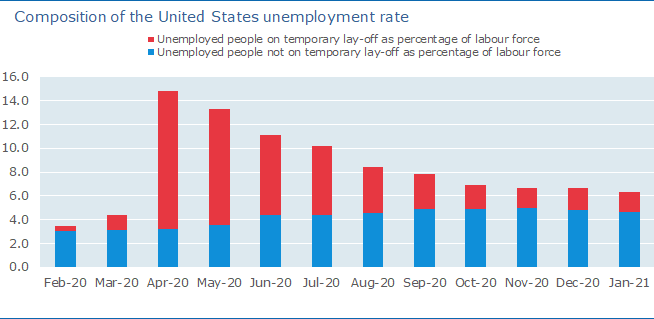OECD unemployment rate stable at 6.9% in December 2020, 1.7 percentage points higher than in February 2020

The OECD area unemployment rate was stable at 6.9% in December 2020, remaining 1.7 percentage points above the level observed in February 2020, before the COVID-19 pandemic hit the labour market.
In December, the unemployment rate was also stable in the euro area, at 8.3% (1.1 percentage points above its February 2020 level), with falls of 0.2 percentage point or more in Belgium, Lithuania, Portugal and Slovenia and increases of 0.2 percentage point or more in Austria, Finland, Italy and Luxembourg.
In the United States, where the number of people on temporary lay-off has been relatively steady since October (see Figure 2), the unemployment rate was stable at 6.7%, 3.2 percentage points higher than in February 2020. In Canada, it increased by 0.2 percentage point (to 8.8%). More recent data for January 2021 show that the unemployment rate declined by 0.4 percentage point in the United States (to 6.3%) while it continued to rise (by 0.6 percentage point, to 9.4%) in Canada. In December, the unemployment rate was unchanged in Japan, at 2.9% (0.5 percentage point above its pre-pandemic level). It increased by 0.5 percentage point in Korea (to 4.6%), while it continued to decline in Australia (to 6.6% in December, from 6.8% in November), Colombia (to 14.6%, from 15.3%) and Mexico (to 4.2%, from 4.5%).

Source: Labour Force Statistics Link to underlying data
In spite of stable aggregate unemployment rates in the OECD and the euro area, in December, the OECD youth unemployment rate (people aged 15 to 24) increased slightly to 14.4% (from 14.2% in November). In the euro area the youth unemployment rate increased to 18.5% (from 18.1% in November), the second consecutive monthly increase.

Source: OECD calculations, based on US Current Population Survey
More generally, it should be noted that unemployment statistics do not account for the full amount of labour market slack due to Covid-19, as some non-employed people may be classified as “out of the labour force” because, due to the pandemic, they are either not able to actively look for a job or are not available to work.
Source: OECD

 Hellenic Shipping News Worldwide Hellenic Shipping News Worldwide, Online Daily Newspaper on Hellenic and International Shipping
Hellenic Shipping News Worldwide Hellenic Shipping News Worldwide, Online Daily Newspaper on Hellenic and International Shipping





















 PG-Software
PG-Software